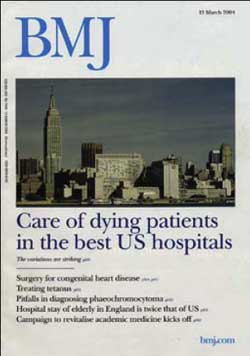Vital Signs:
Striking variations revealed in end-of-life care at "best hospitals"
In a study of 77 hospitals listed in U.S. News & World Report's 2001 "America's Best Hospitals" issue, Dr. John Wennberg and colleagues discovered "huge differences" in the management of patients with chronic illness during the last six months of life. An international authority on geographic variations in medical practice patterns and the director of Dartmouth's Center for the Evaluative Clinical Sciences, Wennberg says this study was the first to focus on variations among specific hospitals rather than among regions. The study was the cover article in the March 13 British Medical Journal.

|
| The British Medical Journal deemed this DMS study to be cover-worthy. |
Disparities: Despite the fact that the hospitals chosen for the study were academic medical centers with strong reputations for geriatric care and for treatment of heart disease, cancer, and pulmonary disease (all common causes of death), they showed marked disparities-almost sixfold in some cases-in the use of key hospital and physician services. Using Medicare hospital admission files for patients who died in 1999 and 2000, the researchers compared the number of hospital days, number of ICU days, number of physician visits, percentage of patients seeing 10 or more physicians, and percentage of patients enrolled in hospice care.
Nationwide, the study found that hospital days per patient during the last six months of life ranged from 9.4 to 27.1; ICU days ranged from 1.6 to 9.5; and the number of physician visits from 17.6 to 76.2. The percentage of patients who saw more than 10 physicians ranged from 15.9% to 58.8%, while hospice enrollment ranged from 10.8% to 43.8%.
Even within the same city, different hospitals revealed significant differences in patterns of patient management. In Los Angeles, for example, the average number of hospital days per decedent was 16.1 at UCLA Medical Center and 21.3 at Cedars-Sinai Medical Center, while the number of physician visits was 43.9 at UCLA and 66.2 at Cedars-Sinai.
Such wide swings in key indicators suggest, Wennberg says, that the best hospitals have no agreed-upon standards for making decisions about patient management. "We would expect academic medical centers to be more science-based," he explains, "but they seem to have no special expertise when it comes to end-of-life care."
Beds: Indeed, this study corroborates earlier findings that decisions about hospital admissions and other services are based more on the number of available physicians and hospital beds than on patients' preferences or the severity of their illnesses.
Furthermore, the patients receiving more care did not have better health outcomes. Strikingly, very high use of medical services actually led to worse outcomes. "Quality and access to care were slightly worse in higher- spending regions, and mortal-
Striking variations revealed in end-of-life care at "best hospitals" ity was between 2% and 5% higher, suggesting that overuse of supply-sensitive services was leading to harm, possibly because greater use of hospital and specialist care exposes populations to greater risks of medical errors," the study authors concluded.
In Britain, where reform of the National Health Service is under way, such findings are of particular interest. In a commentary on Wennberg's article, Dr. David Hunter, a professor of health policy at Britain's University of Durham, concludes, "Perhaps the most important lesson arising from the study is that if real change in the way health systems function is to occur, then far greater attention must be given to the way clinicians operate and manage resources throughout the care pathway."
Findings: In the U.S., too, the study suggests, academic medical centers need to heed the findings if they are to maintain their reputation for providing the highest quality health care.
"We need to create actionable information so something can be done," says Wennberg.
Catherine Tudish
If you would like to offer any feedback about this article, we would welcome getting your comments at DartMed@Dartmouth.edu.
